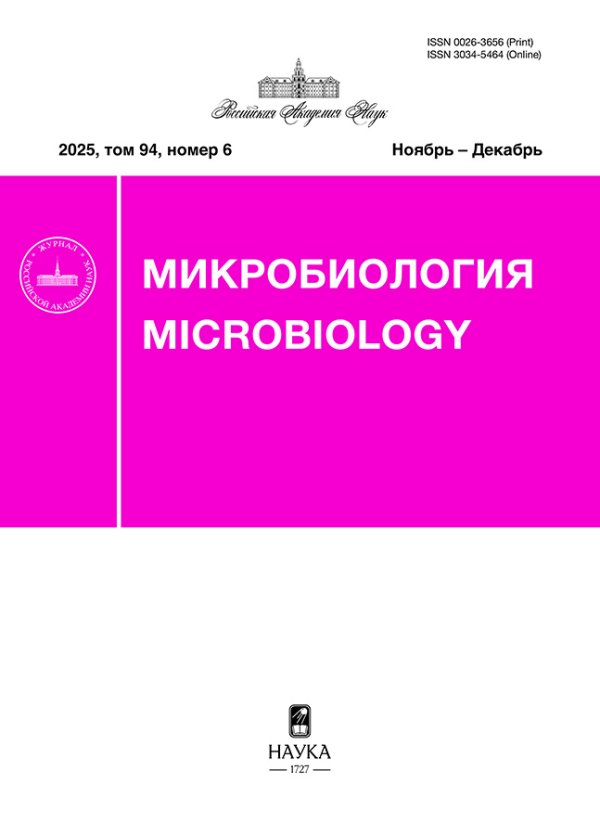Glycoside Hydrolases of the Obligate Methanotroph Methyloferula stellata: an Unusual Evolutionary Strategy not Involving Distant Lateral Transfers
- Authors: Naumoff D.G.1, Dedysh S.N.1
-
Affiliations:
- Winogradsky Institute of Microbiology, Research Center of Biotechnology, Russian Academy of Sciences
- Issue: Vol 92, No 3 (2023)
- Pages: 243-249
- Section: EXPERIMENTAL ARTICLES
- URL: https://journals.rcsi.science/0026-3656/article/view/138208
- DOI: https://doi.org/10.31857/S002636562260078X
- EDN: https://elibrary.ru/FWAFVA
- ID: 138208
Cite item
Full Text
Abstract
Abstract—
The genome of the obligately methanotrophic bacterium Methyloferula stellata AR4 encodes thirty glycoside hydrolases. The closest homologues for most of these proteins belong to other members of the class Alphaproteobacteria. Two exceptions are represented by the genes encoding glycoside hydrolases of the families GH39 and GH65, which presumably appeared in M. stellata AR4 due to the lateral transfer from distantly related bacteria. This work was devoted to the study of the evolutionary history of these two genes. In the case of a member of the GH65 family of glycoside hydrolases, this scenario was not confirmed. Kojibiose phosphorylase encoded by this gene is common among Alphaproteobacteria. The suggested lateral transfer of the corresponding gene had an opposite direction, into one of the evolutionary lineages of the class Betaproteobacteria. The potential glycoside hydrolase of the GH39 family was shown to be the only one which gene is not of proteobacterial origin. The role of lateral transfers in the evolution of glycoside hydrolases and their homologues in methanotrophs and other bacteria is discussed.
About the authors
D. G. Naumoff
Winogradsky Institute of Microbiology, Research Center of Biotechnology, Russian Academy of Sciences
Author for correspondence.
Email: daniil_naumoff@yahoo.com
Russia, 119071, Moscow
S. N. Dedysh
Winogradsky Institute of Microbiology, Research Center of Biotechnology, Russian Academy of Sciences
Email: daniil_naumoff@yahoo.com
Russia, 119071, Moscow
References
- Наумов Д.Г. Иерархическая классификация гликозил-гидролаз // Биохимия. 2011. Т. 76. С. 764–780.
- Naumoff D.G. Hierarchical classification of glycoside hydrolases // Biochemistry (Moscow). 2011. V. 76. P. 622–635.
- Наумов Д.Г. Семейство GH10 гликозилгидролаз: структура и эволюционные связи // Мол. биология. 2016. Т. 50. С. 151–160.
- Naumoff D.G. GH10 family of glycoside hydrolases: structure and evolutionary connections // Mol. Biol. (Moscow). 2016. V. 50. P. 132–140.
- Наумов Д.Г., Иванова А.А., Дедыш С.Н. Филогения β‑ксиланаз планктомицетов // Мол. биология. 2014. Т. 48. С. 508–517.
- Naumoff D.G., Ivanova A.A., Dedysh S.N. Phylogeny of β‑xy-lanases from Planctomycetes // Mol. Biol. (Moscow). 2014. V. 48. P. 439–447.
- Наумов Д.Г., Куличевская И.С., Дедыш С.Н. Генетические детерминанты утилизации ксилана у планктомицета класса Phycisphaerae, Humisphaera borealis M1803T // Микробиология. 2022. Т. 91. С. 300–311.
- Naumoff D.G., Kulichevskaya I.S., Dedysh S.N. Genetic determinants of xylane utilization in Humisphaera borealis M1803T, a planctomycete of the class Phycisphaerae // Microbiology (Moscow). 2022. V. 91. P. 249–258.
- Corrêa J.M., Graciano L., Abrahão J., Loth E.A., Gandra R.F., Kadowaki M.K., Henn C., Simão Rde C. Expression and characterization of a GH39 β-xylosidase II from Caulobacter crescentus // Appl. Biochem. Biotechnol. 2012. V. 168. P. 2218–2229.
- Coutinho P.M., Stam M., Blanc E., Henrissat B. Why are there so many carbohydrate-active enzyme-related genes in plants? // Trends Plant Sci. 2003. V. 8. P. 563–565.
- De Beul E., Jongbloet A., Franceus J., Desmet T. Discovery of a kojibiose hydrolase by analysis of specificity-determining correlated positions in glycoside hydrolase family 65 // Molecules. 2021. V. 26. Art. 6321.
- Dedysh S.N., Haupt E.S., Dunfield P.F. Emended description of the family Beijerinckiaceae and transfer of the genera Chelatococcus and Camelimonas to the family Chelatococcaceae fam. nov. // Int. J. Syst. Evol. Microbiol. 2016. V. 66. P. 3177–3182.
- Dedysh S.N., Naumoff D.G., Vorobev A.V., Kyrpides N., Woyke T., Shapiro N., Crombie A.T., Murrell J.C., Kalyuzhnaya M.G., Smirnova A.V., Dunfield P.F. Draft genome sequence of Methyloferula stellata AR4, an obligate methanotroph possessing only a soluble methane monooxygenase // Genome Announc. 2015. V. 3. Art. e01555-14.
- Drula E., Garron M.-L., Dogan S., Lombard V., Henrissat B., Terrapon N. The carbohydrate-active enzyme database: functions and literature // Nucl. Acids Res. 2022. V. 50 (Database issue). P. D571–D577. (http://www.cazy.org/).
- Haque M.F.U., Hernández M., Crombie A.T., Murrell J.C. Identification of active gaseous-alkane degraders at natural gas seeps // ISME J. 2022. V. 16. P. 1705–1716.
- Miroshnikov K.K., Didriksen A., Naumoff D.G., Huntemann M., Clum A., Pillay M., Palaniappan K., Varghese N., Mikhailova N., Mukherjee S., Reddy T.B.K., Daum C., Shapiro N., Ivanova N., Kyrpides N., Woyke T., Dedysh S.N., Svenning M.M. Draft genome sequence of Methylocapsa palsarum NE2T, an obligate methanotroph from subarctic soil // Genome Announc. 2017. V. 5. Art. e00504-17.
- Mukherjee K., Narindoshvili T., Raushel F.M. Discovery of a kojibiose phosphorylase in Escherichia coli K-12 // Biochemistry. 2018. V. 57. P. 2857–2867.
- Naumoff D.G. Glycoside hydrolases encoded by the Methyloferula stellata genome // Glycoconjugate J. 2017. V. 34. N. S1. P. S96–S97. (https://www.researchgate.net/public-ation/328772143_Glycoside_hydrolases_encoded_by_the_Methyloferula_stel-lata_genome).https://doi.org/10.1007/s10719-017-9784-5
- Parks D.H., Chuvochina M., Waite D.W., Rinke C., Skarshewski A., Chaumeil P.-A., Hugenholtz Ph. A standardized bacterial taxonomy based on genome phylogeny substantially revises the tree of life // Nat. Biotechnol. 2018. V. 36. P. 996–1004.
- Rakitin A.L., Naumoff D.G., Beletsky A.V., Kulichevskaya I.S., Mardanov A.V., Ravin N.V., Dedysh S.N. Complete genome sequence of the cellulolytic planctomycete Telmatocola sphagniphila SP2T and characterization of the first cellulolytic enzyme from planctomycetes // Syst. Appl. Microbiol. 2021. V. 44. Art. 126276.
- Stam M.R., Danchin E.G., Rancurel C., Coutinho P.M., Henrissat B. Dividing the large glycoside hydrolase family 13 into subfamilies: towards improved functional annotations of α-amylase-related proteins // Protein Eng. Des. Sel. 2006. V. 19. P. 555–562.
- Tamas I., Smirnova A.V., He Z., Dunfield P.F. The (d)evolution of methanotrophy in the Beijerinckiaceae – a comparative genomics analysis // ISME J. 2014. V. 8. P. 369–382.
- Vorobev A.V., Baani M., Doronina N.V., Brady A.L., Liesack W., Dunfield P.F., Dedysh S.N. Methyloferula stellata gen. nov., sp. nov., an acidophilic, obligately methanotrophic bacterium possessing only a soluble methane monooxygenase // Int. J. Syst. Evol. Microbiol. 2011. V. 61. P. 2456–2463.
- Yamamoto T., Maruta K., Mukai K., Yamashita H., Nishimoto T., Kubota M., Fukuda S., Kurimoto M., Tsujisaka Y. Cloning and sequencing of kojibiose phosphorylase gene from Thermoanaerobacter brockii ATCC35047 // J. Biosci. Bioeng. 2004. V. 98. P. 99–106.
- Yamamoto T., Nishio-Kosaka M., Izawa S., Aga H., Nishimoto T., Chaen H., Fukuda S. Enzymatic properties of recombinant kojibiose phosphorylase from Caldicellulosiruptor saccharolyticus ATCC43494 // Biosci. Biotechnol. Biochem. 2011. V. 75. P. 1208–1210.
- Yu S., Su T., Wu H., Liu S., Wang D., Zhao T., Jin Z., Du W., Zhu M.J., Chua S.L., Yang L., Zhu D., Gu L., Ma L.Z. PslG, a self-produced glycosyl hydrolase, triggers biofilm disassembly by disrupting exopolysaccharide matrix // Cell Res. 2015. V. 25. P. 1352–1367.












